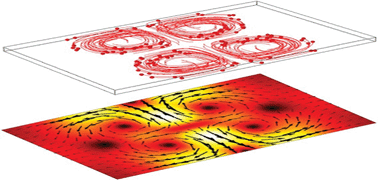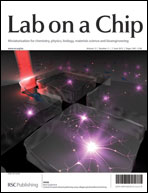Acoustic streaming in the transducer plane in ultrasonic particle manipulation devices†
Abstract
In acoustofluidic manipulation and sorting devices, Rayleigh streaming flows are typically found in addition to the acoustic radiation forces. However, experimental work from various groups has described acoustic streaming that occurs in planar devices in a plane parallel to the transducer face. This is typically a four-quadrant streaming pattern with the circulation parallel to the transducer. Understanding its origins is essential for creating designs that limit or control this phenomenon. The cause of this kind of streaming pattern has not been previously explained as it is different from the well-known classical streaming patterns such as Rayleigh streaming and Eckart streaming, whose circulation planes are generally perpendicular to the face of the acoustic transducer. In order to gain insight into these patterns we present a numerical method based on Nyborg's limiting velocity boundary condition that includes terms ignored in the Rayleigh analysis, and verify its predictions against experimental


 Please wait while we load your content...
Please wait while we load your content...